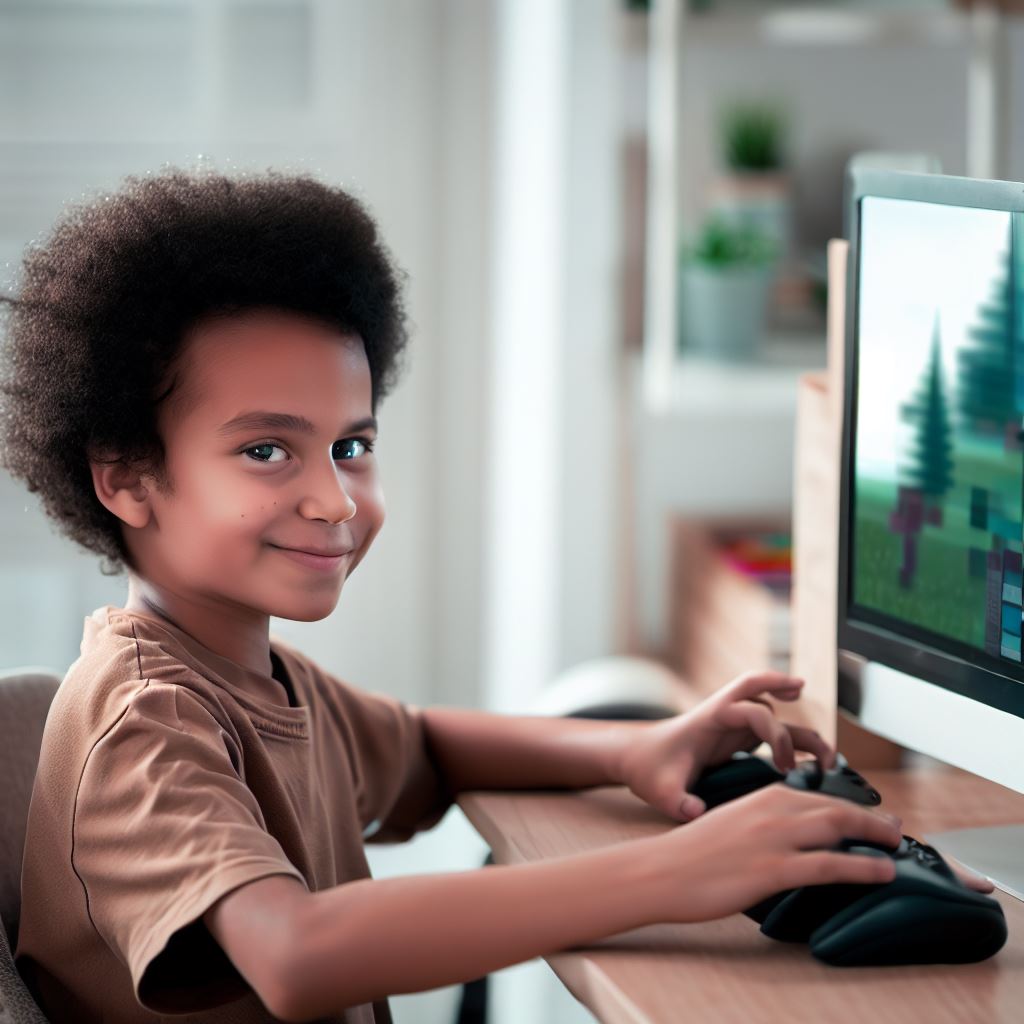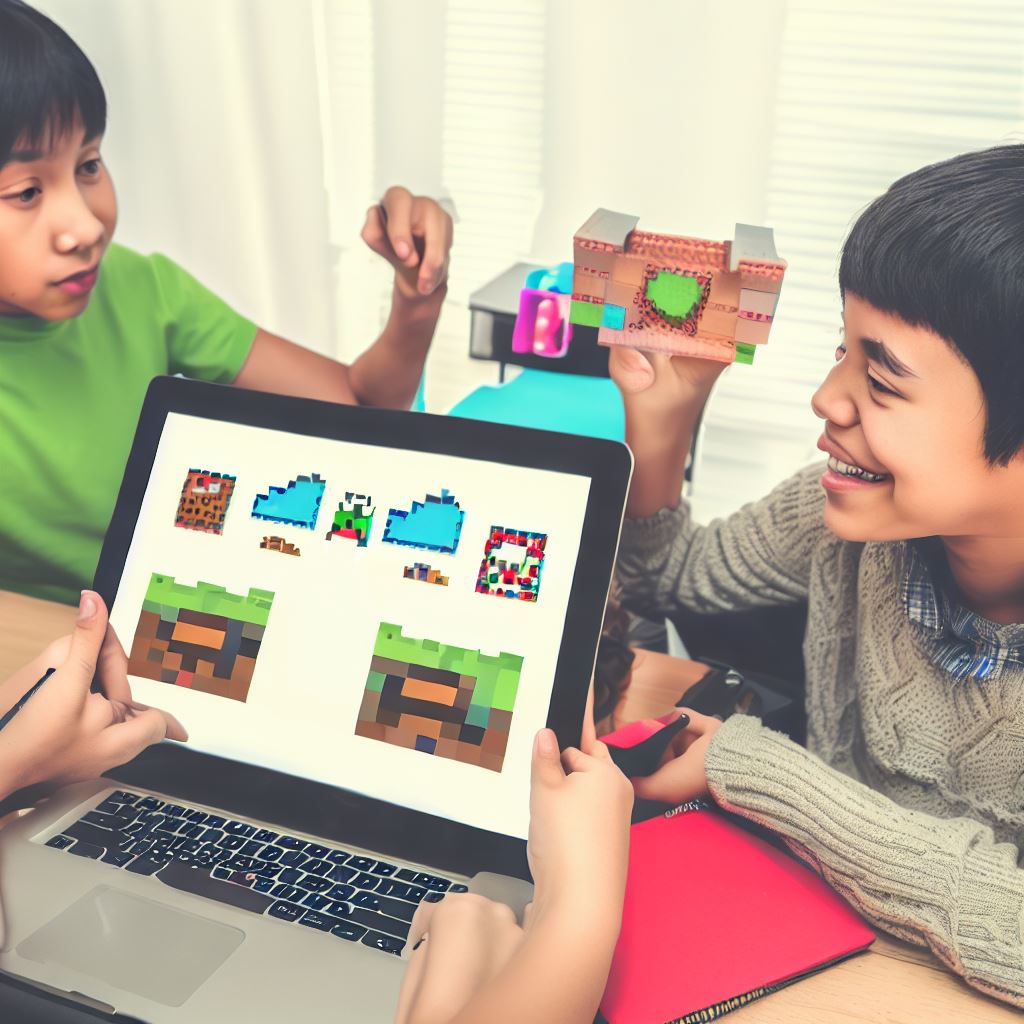Introduction
Minecraft and Scratch are popular platforms that offer unique opportunities for coding enthusiasts.
Minecraft is a virtual world where players can build and explore using textured cubes, while Scratch is an online platform that allows users to program their own interactive stories, games, and animations.
What connects these platforms is the inherent connection to coding. Both Minecraft and Scratch provide a creative and engaging environment for users to learn and apply coding concepts.
In Minecraft, players can use command blocks to create complex mechanisms and automate actions within the game. This introduces basic programming principles such as loops, conditions, and variables.
Scratch, on the other hand, uses a visual programming language where users can drag and drop code blocks to create scripts. This makes coding accessible to beginners, fostering creativity and problem-solving skills.
By using Scratch to control Minecraft through Minecraft: Education Edition, students can combine their coding knowledge with their passion for the game.
It allows them to create mods, mini-games, and challenges for themselves and their peers.
The connection between coding and Minecraft and Scratch provides a unique learning experience that is both fun and educational.
As students code and create within these platforms, they develop computational thinking skills, enhance their problem-solving abilities, and exercise their creativity.
In the following sections, we will delve deeper into the possibilities, benefits, and resources available for coding with Minecraft and Scratch.
Minecraft: An Ideal Environment for Coding
Minecraft is more than just a game; it is also a perfect platform for coding.
With its open-world nature and endless possibilities, Minecraft allows players to unleash their creativity and learn programming skills in a fun and engaging way.
A. The open-world nature of Minecraft
One of the key features that make Minecraft an ideal environment for coding is its open-world nature.
Players are free to explore a vast and procedurally generated world, giving them a sense of limitless possibilities.
In this open-world setting, players can experiment, build, and create to their heart’s content. They can construct towering structures, dig deep mines, or even create complex redstone contraptions.
Tech Consulting Tailored to Your Coding Journey
Get expert guidance in coding with a personalized consultation. Receive unique, actionable insights delivered in 1-3 business days.
Get StartedThis freedom fosters a sense of creativity and problem-solving, which are essential skills in the world of coding.
B. Explaining how players can create and modify their own virtual worlds
In Minecraft, players have the power to create and modify their own virtual worlds using the game’s building blocks.
The game provides a wide variety of materials and tools that allow players to shape the landscape and build structures from scratch.
Players can design and construct entire cities, elaborate castles, or even replicate real-life landmarks.
The ability to customize every aspect of their virtual world gives them a hands-on experience in designing and building, which are fundamental concepts in coding and programming.
C. Examples of Minecraft mods and add-ons created by the community
One of the remarkable aspects of Minecraft is its thriving modding community. Mods are modifications created by players that add new features, gameplay mechanics, or content to the game.
These mods showcase the endless possibilities for creativity and coding within Minecraft.
For example, the “ComputerCraft” mod introduces programmable computers and turtles into the game.
Players can write Lua scripts to control these virtual machines, enabling them to create complex programs and automate tasks within the game.
Other mods like “RedPower” and “IndustrialCraft” add new electrical systems, machines, and automation tools that require intricate programming to fully utilize their capabilities.
These examples illustrate how Minecraft’s modding community expands the coding potential of the game.
D. The use of command blocks in Minecraft for programming-like experiences
Minecraft features an in-game item called command blocks, which allows players to execute commands and create intricate systems and mechanisms.
Command blocks provide a similar experience to programming, as players need to understand logical statements, variables, and loops to make them work effectively.
With command blocks, players can create adventure maps, puzzle games, or even mini-games within Minecraft.
Build Your Vision, Perfectly Tailored
Get a custom-built website or application that matches your vision and needs. Stand out from the crowd with a solution designed just for you—professional, scalable, and seamless.
Get StartedBy using commands and command blocks, players can manipulate the game mechanics, spawn mobs, change the environment, or create custom game rules.
This hands-on experience with programming concepts makes Minecraft an excellent platform for introducing coding to beginners.
Minecraft’s open-world nature, ability to create and modify virtual worlds, thriving modding community, and the use of command blocks all contribute to its appeal as an environment for coding.
Through Minecraft, players can unleash their creativity, develop problem-solving skills, and learn programming concepts in an interactive and enjoyable way.
Read: Pros and Cons: Coding Websites vs Traditional Textbooks
Scratch: The Perfect Tool for Learning Coding
Scratch is a visual programming language that provides an excellent platform for beginners to learn coding. It offers a variety of features that make it user-friendly and engaging.
Introducing Scratch as a visual programming language, it allows users to create programs by dragging and dropping blocks of code.
This simplifies the coding process and makes it accessible to individuals with no prior experience.
One of the greatest advantages of Scratch is its ability to enable users to build interactive stories, games, and animations.
A. The simplicity of Scratch’s drag-and-drop interface
By using Scratch’s intuitive interface, beginners can create engaging projects that come to life on the screen.
Scratch’s drag-and-drop interface is what truly sets it apart from other coding tools.
Users can easily select code blocks and snap them together, eliminating the need to memorize syntax or worry about typos.
This allows beginners to focus on the logic and creativity behind their projects.
B. The strong online community and available resources for learning Scratch
Another remarkable aspect of Scratch is its strong online community. Users can share their projects with others, receive feedback, and collaborate on coding challenges.
Optimize Your Profile, Get Noticed
Make your resume and LinkedIn stand out to employers with a profile that highlights your technical skills and project experience. Elevate your career with a polished and professional presence.
Get NoticedThis sense of community fosters a supportive learning environment and encourages beginners to continue exploring coding concepts.
In addition to its vibrant community, Scratch provides a plethora of resources for learning.
Online tutorials, step-by-step guides, and interactive lessons are readily available, making it easy for beginners to acquire the necessary skills to become proficient in coding.
These resources ensure that learners have access to support and guidance throughout their coding journey.
Furthermore, Scratch’s online platform allows users to access their projects from anywhere, making it convenient for individuals to continue their coding practice outside of the classroom.
This flexibility promotes independent learning and creativity.
Moreover, Scratch encourages experimentation and problem-solving. Users can modify existing projects, tweak variables, and try different combinations of code blocks to see the effects in real-time.
This hands-on approach to learning coding fosters critical thinking skills and encourages users to think creatively to achieve their desired outcomes.
Scratch’s versatility extends beyond its capabilities as a coding tool. It is also an excellent tool for teaching computational thinking, a key skill for today’s technology-driven world.
By working on Scratch projects, learners develop problem-solving skills, learn to break down complex problems into simpler steps, and gain a deeper understanding of logical thinking.
Basically, Scratch is the ideal tool for learning coding.
Its visual programming language, interactive capabilities, drag-and-drop interface, strong community, and abundance of learning resources make it an exceptional platform for beginners.
With Scratch, coding becomes accessible, engaging, and enjoyable, setting learners on a path to becoming proficient programmers.
Read: Semantic HTML: Why It’s Important for Web Accessibility

The Synergy Between Minecraft and Scratch
- Scratch can be used to program Minecraft-related projects, allowing for endless creative possibilities.
- There are various Minecraft-related extensions available in Scratch, enhancing the gaming experience with coding elements.
- Let me share some examples of coding-based projects that combine the power of Minecraft and Scratch.
A. Exploring Minecraft with Scratch
One popular way to integrate Scratch and Minecraft is by creating interactive stories set in the blocky, virtual world.
Users can design a narrative using Scratch’s visual programming interface, incorporating characters, dialogue, and even mini-games.
For example, a Scratch project may involve a quest where the player has to navigate through different challenges within the Minecraft universe.
By combining coding logic and gameplay mechanics, the project becomes an immersive and educational experience.
B. Minecraft-related Extensions in Scratch
Scratch’s extensive library of extensions includes Minecraft-specific features. Users can control Minecraft characters and manipulate their environment using Scratch’s block-based coding system.
With these extensions, users can create custom blocks, modify terrain, and interact with objects in the Minecraft world.
This integration between Scratch and Minecraft empowers young coders to design and build their own Minecraft adventures.
C. Examples of Minecraft-Scratch Projects
Let’s take a look at a couple of projects that highlight the synergy between Minecraft and Scratch:
- Treasure Hunt: Users can design a treasure hunt game in Scratch, where players follow clues and navigate through a custom-built Minecraft world to find hidden treasures.
- Virtual Architecture: With Scratch and Minecraft, users can design and build virtual structures, exploring architectural concepts in an interactive and engaging way.
By combining the environments of Scratch and Minecraft, these projects foster creativity and problem-solving skills while providing an educational platform.
D. Educational Benefits
The synergy between Minecraft and Scratch offers numerous educational benefits:
- Enhances problem-solving skills by challenging users to think critically and logically in a virtual environment.
- Promotes creativity through designing and building unique projects, encouraging experimentation and innovation.
- Integrates coding concepts into a popular gaming platform, making programming more accessible and enjoyable for young learners.
The integration of Scratch and Minecraft opens up a world of possibilities for educators, allowing them to teach coding and computational thinking in a fun and engaging way.
Read: Why You Shouldn’t Code for Hours Without Breaks
Gain More Insights: Create a ‘Hello World’ Program in Go: A Beginner’s Guide
Discover More: Free Coding Bootcamps for Women: Closing the Tech Gap
Minecraft and Scratch in Education
A. The use of Minecraft and Scratch in educational settings
In today’s rapidly evolving digital world, it is becoming increasingly important for educators to incorporate technology into their teaching strategies.
One highly effective and engaging way to teach coding concepts is through the use of Minecraft and Scratch, two popular platforms that have gained significant traction in educational settings.
B. The popularity of coding camps and workshops centered around these platforms
Minecraft, a sandbox video game, allows users to create and build virtual worlds using various blocks and materials.
Similarly, Scratch is a block-based coding platform developed by MIT that enables users to create interactive stories, games, and animations.
These platforms provide students with hands-on experiences that make coding both enjoyable and accessible.
The use of Minecraft and Scratch in educational settings has gained significant popularity in recent years.
Many schools and organizations have implemented coding camps and workshops centered around these platforms.
These educational programs provide students with the opportunity to learn coding concepts in a fun and interactive way.
C. The benefits of using Minecraft and Scratch for teaching coding concepts
One of the key benefits of using Minecraft and Scratch for teaching coding is the engagement it offers students.
Both platforms provide a visual and interactive interface that captures students’ attention and encourages their active participation.
This engagement translates into increased motivation and interest in learning coding concepts.
Minecraft and Scratch also aid in the development of problem-solving and critical thinking skills.
By creating and programming their own virtual worlds or interactive stories, students are required to think logically and strategically.
They learn how to break down complex problems into smaller, more manageable tasks, fostering skills that are essential for success in today’s fast-paced technological society.
Furthermore, using Minecraft and Scratch in coding education has been proven to enhance collaboration and teamwork.
Many coding programs using these platforms encourage students to work together, either by sharing their creations or collaborating on their projects.
This collaborative environment fosters communication and cooperation among students, promoting the development of essential social skills alongside coding proficiency.
D. Success stories and research findings demonstrating the positive impact on students’ learning
Several success stories and research findings have demonstrated the positive impact of Minecraft and Scratch on students’ learning outcomes.
For example, a study conducted by researchers at the University of California, Irvine, found that students who utilized Minecraft in coding instruction demonstrated improved problem-solving abilities compared to traditional instructional methods.
Additionally, numerous anecdotal accounts highlight the transformative effect that using these platforms can have on students’ attitudes towards coding.
Many students who previously found coding intimidating or boring have discovered a newfound passion and confidence in their abilities through their experiences with Minecraft and Scratch.
Lastly, the use of Minecraft and Scratch in educational settings offers many benefits for teaching coding concepts.
These platforms provide a highly engaging and interactive learning experience, fostering essential skills such as problem-solving, critical thinking, and collaboration.
The positive impact on students’ learning outcomes, as demonstrated through success stories and research findings, further emphasizes the value of incorporating these platforms into coding education.
Conclusion
We have explored the powerful combination of Minecraft and Scratch for coding. By using these platforms, students can learn and practice coding in a fun and engaging way.
Throughout this blog post, we have discussed how Minecraft introduces the concept of coding through its block-based building system.
Similarly, Scratch provides a visual coding environment that allows users to create their own games and interactive stories.
By combining the creativity and problem-solving skills inspired by Minecraft with the coding capabilities of Scratch, students can develop a strong foundation in computer programming.
They can experiment with coding concepts such as loops, conditionals, and variables, while also learning to think critically and logically.
Not only do Minecraft and Scratch make coding accessible and enjoyable, but they also encourage collaboration and community learning.
Students can share their projects and learn from each other’s creations, fostering a sense of teamwork and innovation.
Therefore, we encourage readers to explore and experiment with coding using Minecraft and Scratch.
Whether you are a student, educator, or coding enthusiast, these platforms provide an excellent opportunity to enhance your coding skills and explore the world of computer science.
So, dive in and start coding with Minecraft and Scratch, and let your creativity and problem-solving skills soar!




